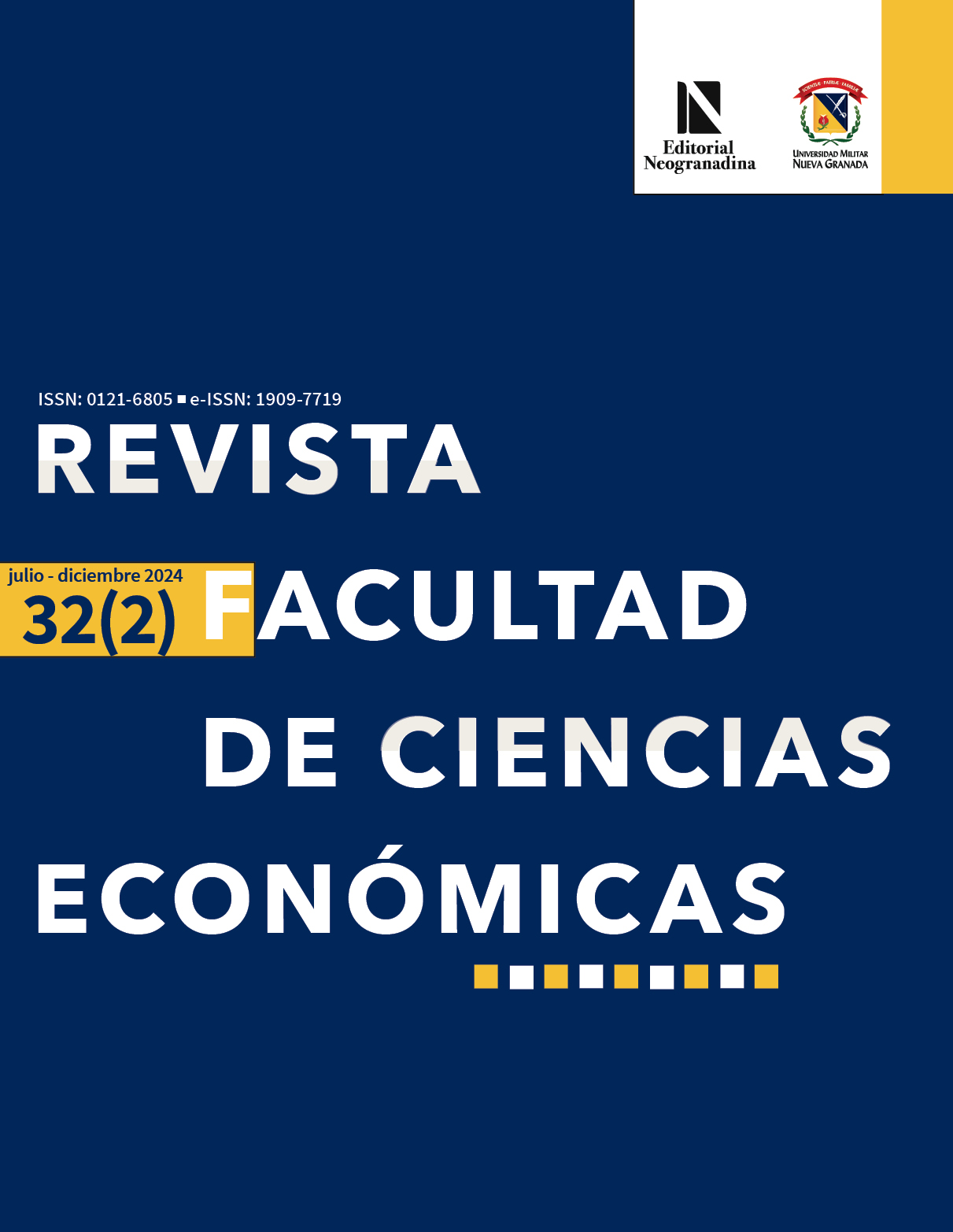Impact of Foreign Direct Investment on Climate Change and Employment in Colombia, Reflections within the Framework of Sustainable Development
Abstract
This article evaluates the impact of foreign direct investment (FDI) on employment and its quality, and on climate change, within the framework of discussions on sustainable development. Initially, a reflection is made on the concept of sustainable development to understand it broadly. In a second part, the type of FDI that has entered Colombia is characterized, showing that one of the main receiving sectors has been the mining-energy sector and the acquisition of existing companies in sectors such as services and manufacturing. Then, the sectoral impact of employment in Colombia and the type of investment is generally analyzed based on the relationship that exists between the type of investment and job creation, and production and sectoral employment elasticities. On the other hand, the environmental impact evidenced by greenhouse gas emissions is evaluated. For the latter, the relationship between economic growth and environmental degradation is analyzed in order to determine if FDI has had any direct or indirect effect on the increase in gas emissions into the atmosphere.
Downloads
References
Abeles, M. y Grimberg, F. (2018). El proceso de apertura económica y su relación con la dinámica laboral en América Latina y Colombia: análisis de la década de 1990 y sus alrededores. En Estudios sobre Financiarización en América Latina, 1(3).
Acevedo-Ramos, J. A., Valencia, C. F., Valencia, C. D. (2023). The environmental Kuznets curve hypothesis for Colombia: Impact of economic development on greenhouse gas emissions and ecological footprint. Sustainability, 15(4), 3738.
https://doi.org/10.3390/su15043738
Afesorgbor, S. K. y Demena, B.A. (2022). Trade openness and environmental emissions: Evidence from a meta-Analysis. https://doi.org/10.1007/s10640-021-00627-0
Environmental and Resource Economics, 81, 287-321. https://doi.org/10.1007/s10640-021-00627-0
Albor, G., Frasser, J. y Andapiña, D. (2017). Desarrollo sostenible, modelo extractivista e inversión extranjera en Colombia. Revista de Economía del Caribe, 19, 34-63.
Allard, A., Takman, J., Uddin, G. y Ahmed, A. (2018). The N-shaped environmental Kuznets curve: an empirical evaluation using a panel quantile regression approach. Environmental Science and Pollution Research, 25, 5848-5861. https://doi.org/10.1007/s11356-017-0907-0
Attanasio, O., Goldberg, P. K. and Pavcnik, N. (2004). Trade reforms and wage inequality in Colombia. In Macroeconomichttps://doi.org/10.3386/w9830
Policies and Poverty (pp. 229-266). Routledge. https://doi.org/10.1016/j.jdeveco.2003.07.001
https://doi.org/10.1016/j.jdeveco.2003.07.001
Banco de la República. (2017). Manual de Balanza de Pagos y Posición de Inversión Internacional. Sexta versión. Fondo Monetario Internacional. https://www.banrep.gov.co/sites/default/files/bp_metodologia_bpm6_v4.pdf
Benavides-Rodríguez, G. M. (2021). El proceso de apertura económica y su relación con la dinámica laboral en América Latina y Colombia: análisis de la década de 1990 y sus alrededores. En Estudios sobre Financiarización en América Latina, 1(3).
Berman, E., Bound, J. and Machin, S. (1998). Implications of skill-biased technological change: international evidence. https://doi.org/10.2139/ssrn.89488
The Quarterly Journal of Economics, 113(4). Oxford University Press. https://doi.org/10.1162/003355398555892
Bonilla Olano, E. (2010). El sector externo y su incidencia en la ocupación en Colombia 1985-2006. Equidad y Desarrollo, https://doi.org/10.19052/ed.208
Calvo, L. A. (2013). Medición de la relación entre crecimiento económico y emisiones de CO2 y PM10 en Colombia: una estimación de la curva de Kuznets ambiental [Tesis de pregrado, Pontificia Universidad Javeriana, Colombia].
Castoriades, C. (2000). La racionalidad del capitalismo. Ensayo y Error, 7.
Catalán, H. (2014). Curva ambiental de Kuznets: implicaciones para un crecimiento sustentable. Economía Informa, 389, 19-37. https://doi.org/10.1016/S0185-0849(14)72172-3
Cavanaugh, J. and Neath, A. (1999). Generalizing the derivation of the Schwarz information criterion. Theory and Methods, 28(1), 49-66. https://doi.org/10.1080/03610929908832282
Comisión Económica para América Latina y el Caribe (Cepal). (2013). Efectos de la inversión extranjera directa sobre el empleo en América Latina y el Caribe. En La Inversión Extranjera Directa en América Latina y el Caribe (pp. 109-142).
Cepal. https://doi.org/10.18356/29bd2867-es
Correa, F. J., Vasco, A. y Pérez, C. (2005). La curva medioambiental de Kuznets: evidencia empírica para Colombia. Semestre Económico, 8(15), 13-30.
Departamento Nacional de Planeación (DNP). (2015). El sistema general de regalías de Colombia en tres años de implementación. Ponente: Simón Gaviria. Seminario Regalías y calidad: una inversión en Colombia.
Dobson, A. (1999, julio). El liberalismo y la política ecológica. En Revista Internacional de Filosofía Política (RIFP), 13, 11-20.
Doeringer, B. and Piore, M. (1971). Internal labor markets and manpower analysis. Lexington, MA, Heath.
Duque, F. (2014). La filosofía de la técnica de la naturaleza. Fondo Editorial ITM.
Echandi, R., J. Krajcovicova and C. Qiang. (2015, octubre). The impact of investment policy in a changing global economy: a review of the literature. Policy Research Working Paper, 7437. Banco Mundial. https://doi.org/10.1596/1813-9450-7437
Ernst, H., Berg, J., Auer, P. y Schuschny, A. (2007). Retos en materia de empleo y respuestas de política en Argentina, Brasil y México. Revista Cepal, 91. https://doi.org/10.18356/80e2b199-es
Escobar, A. y Pedroza, Á. (1996). Institucionalización del desarrollo. En Pacífico, ¿desarrollo o diversidad? Gente Nueva.
Feenstra, R. and Hanson, G. H. (1997). Foreign direct investment and relative wages: evidence from Mexico's maquiladoras. Journal of International Economics, 42(3-4). Elsevier.
https://doi.org/10.1016/S0022-1996(96)01475-4
François, J. (2017). No hay identidad cultural. Lerner.
Garrido, F. y Serrano, J. L. (1999). Mercado y Crisis Ecológica. En Revista Internacional de Filosofía Política (RIFP), 97-117.
Griñán, S. (s. f.). Diferentes enfoques del análisis del empleo en la teoría económica. Contribuciones a la Economía. Eumed. www.eumed.net/ce/2007b/scg.htm
Guisán, C. (2002). Causalidad y cointegración en modelos econométricos: aplicaciones a los países de la OCDE y limitaciones de los test de cointegración. Working Paper Series Economic Development, 61.
Igan, D. and Tan, Z. (2015). Capital in lows, credit growth, and inancial systems. IMF. https://doi.org/10.2139/ssrn.2659550
Krugman, P. R. (2000, 1 enero). Economía Internacional: Teoría y Política. 4a. edición (edición en español). McGraw Hill.
Kugler, M. (2006, agosto). Spillovers from foreign direct investment: Within or between industries? Journal of Development Economics, 80(2), 444-477. https://doi.org/10.1016/j.jdeveco.2005.03.002
Laverde-Rojas, H., Guevara-Fletcher, D. and Camacho-Murillo, A. (2021). Economic growth, economic complexity, and carbon dioxide emissions: The case of Colombia. Heliyon, 7(6), e07188,
https://doi.org/10.1016/j.heliyon.2021.e07188
Mancuso, S. (2017). El futuro es vegetal. Galaxia Gutenberg.
Medel, C. (2012). ¿Akaike o Schwarz? ¿Cuál elegir para predecir el PIB chileno? Documento de trabajo, 658, Banco Central de Chile.
Morán, J. (2005). La economía comunal. Contribuciones a la economía. Eumed. http://www.eumed.net/libros/2007c/335/index.htm
Prebisch, R. (1973). Problemas teóricos y prácticos del crecimiento económico. Cepal. https://repositorio.cepal.org/entities/publication/70e11a1e-cd96-4f59-a19d-9b31467014c8
Rodríguez-Albor, G, Frasser, J. y Andapiña, D. (2017). Desarrollo sostenible, modelo extractivista e inversión extranjera en Colombia. Revista de economía del Caribe, 19, 34-64.
Rodrik, D. (1997). La globalización ha ido demasiado lejos. Institute for International Economics. 183. Impacto de la inversión extranjera directa sobre el cambio climático y el empleo en Colombia: reflexiones en el marco del desarrollo sostenible, Revista Facultad de Ciencias Económicas ■ Vol. 32(2)
Rosset, C. (1973). La antinaturaleza, elementos para una filosofía trágica. Presses Universitaires de France.
Ruiz-Agudelo, C. A., Sánchez Pérez, G., Sáenz, J. E. and Higuera Cárdenas, L. A. (2018). Biodiversity and growth in Colombia, 1995-2015: an approach from the environmental Kuznets hypothesis. Journal of Environmental Economics and Policy, 8(1), 17-31. https://doi.org/10.1080/21606544.2018.1491894
Silva, M. y Madeira, J. (2015). Inversión extranjera directa y medio ambiente: estado del arte en la investigación. Economía, XL, 39, 11-36.
Simmel, G. (2014). La filosofía del paisaje. Casimiro libros.
Serres, M. (2004). El contrato natural. Pre-Textos.
Sosa, P. V. y Navarro, D. M. (2020). Crecimiento, complejidad económica y emisiones de CO2: un análisis para Colombia. https://doi.org/10.15332/22484914/6039
Revista CIFE: Lecturas de Economía Social, 22(37), 21-41. https://doi.org/10.15332/22484914/6039
https://doi.org/10.15332/22484914/6039
Suanez, M. (2016). Foreign direct investment and income inequality in Latin America: a sectoral analysis. Cepal Review, https://doi.org/10.18356/13c68e36-en
Stiglitz, J. and Shapiro, C. (1984). Unemployment as a worker discipline device. The American Economic Review, 3(74).
Thirlwall, A. P. (1979). The balance of payments constraint as an explanation of international growth rate differences. BNLQuarterly Review, 32(128), 45-53.
Tondl, G. and Fornero, J. (2017). Sectoral productivity and spillover effects of FDI in Latin America. Research Centre International Economics, 53.
Wissemburg, M. (1999). Democracia liberal sostenible. En RIFP, 41-63
Funding data
Copyright (c) 2024 Revista Facultad de Ciencias Económicas

This work is licensed under a Creative Commons Attribution-NonCommercial-NoDerivatives 4.0 International License.











